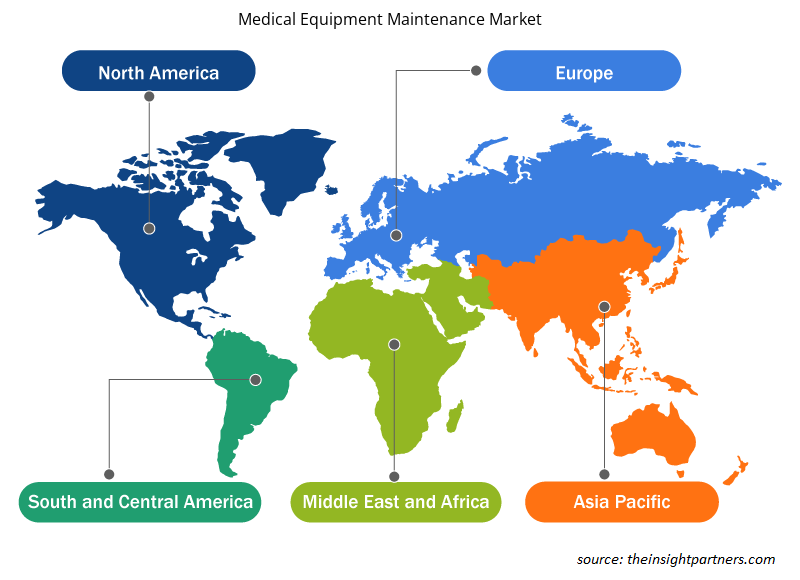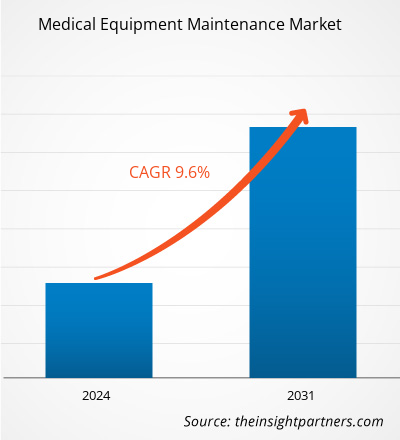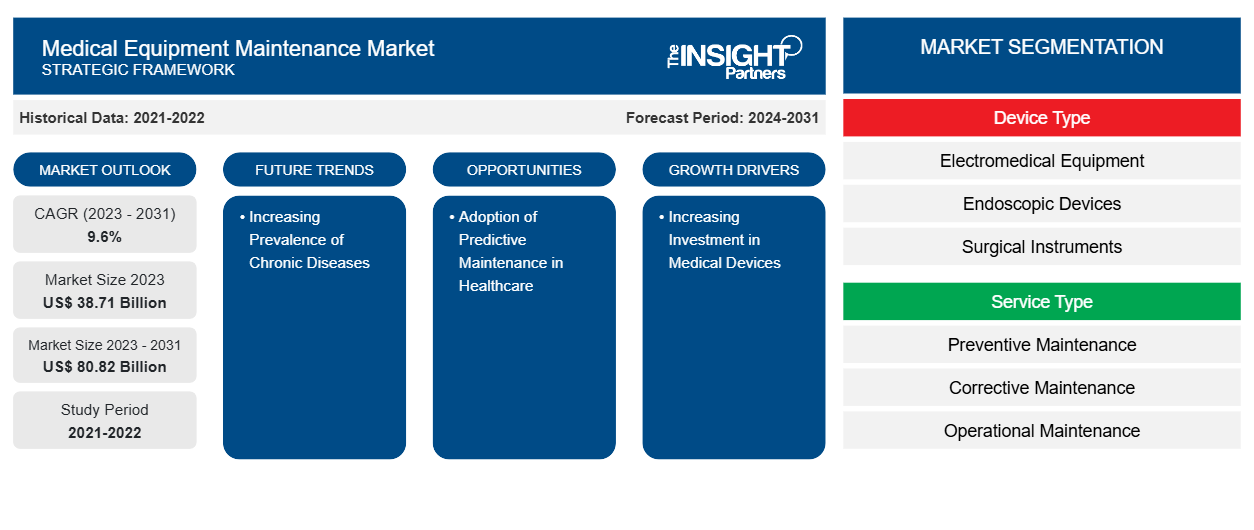El tamaño del mercado de mantenimiento de equipos médicos en 2023 se situó en 38.710 millones de dólares y se prevé que alcance los 80.820 millones de dólares en 2031. Se espera que el mercado registre una CAGR del 9,6 % durante 2023-2031. Es probable que los avances tecnológicos en equipos médicos y de diagnóstico sigan siendo tendencias clave en el mercado.
Análisis del mercado de mantenimiento de equipos médicos
El rápido crecimiento del mercado de equipos médicos a nivel mundial y el uso cada vez mayor del mantenimiento correctivo están impulsando la demanda de mantenimiento de equipos médicos. La mayor prevalencia de enfermedades crónicas en la población contribuye significativamente a la demanda de mantenimiento de equipos médicos. La innovación en las ofertas de servicios y el uso de IoT están creando oportunidades para el mercado de mantenimiento de equipos médicos.
Descripción general del mercado de mantenimiento de equipos médicos
En el mercado de mantenimiento de equipos médicos, los proveedores de servicios atienden una amplia gama de necesidades, incluidas las reparaciones correctivas de equipos médicos duraderos y servicios especializados para centros de diálisis. Con énfasis en el cumplimiento normativo, incluidos el cáncer y los trastornos del estilo de vida, las empresas brindan soluciones tanto para fabricantes de equipos originales de varios proveedores como para fabricantes de un solo proveedor.
Personalice este informe según sus necesidades
Obtendrá personalización en cualquier informe, sin cargo, incluidas partes de este informe o análisis a nivel de país, paquete de datos de Excel, así como también grandes ofertas y descuentos para empresas emergentes y universidades.
-
Obtenga las principales tendencias clave del mercado de este informe.Esta muestra GRATUITA incluirá análisis de datos, desde tendencias del mercado hasta estimaciones y pronósticos.
Impulsores y oportunidades del mercado de mantenimiento de equipos médicos
Aumentar la inversión en dispositivos médicos favorecerá el crecimiento del mercado
El sector sanitario está experimentando un aumento de la inversión en dispositivos médicos como máquinas de rayos X, centrífugas, unidades de ventilación, ultrasonidos, bombas de jeringa, electrocardiógrafos y autoclaves, lo que aumenta principalmente la necesidad de servicios de mantenimiento de equipos médicos. El mantenimiento de los equipos médicos es esencial para garantizar que funcionen correctamente y sean seguros para el uso del paciente. Los centros sanitarios dependen cada vez más de los proveedores de servicios de mantenimiento para mantener sus equipos en buen estado de funcionamiento y reducir el tiempo de inactividad. Los equipos médicos modernos deben recibir mantenimiento de forma periódica para garantizar su correcto funcionamiento. La complejidad de los nuevos equipos médicos está aumentando la demanda de conocimientos especializados de mantenimiento.
Adopción del mantenimiento predictivo en la atención sanitaria
El mantenimiento predictivo en el ámbito sanitario consiste en la supervisión y la gestión proactivas de los equipos médicos para evitar tiempos de inactividad no planificados y garantizar un rendimiento óptimo. A diferencia de los métodos de mantenimiento tradicionales, que se basan en cronogramas fijos o respuestas reactivas a fallos de los equipos, el mantenimiento predictivo emplea datos en tiempo real y análisis predictivos para prever posibles dificultades y priorizar las tareas de mantenimiento en función del riesgo y la criticidad. Las organizaciones sanitarias pueden pasar de métodos de mantenimiento reactivos a proactivos empleando tecnologías modernas como sensores, análisis de datos y aprendizaje automático. Esto reducirá los costes, mejorará la eficiencia y mejorará la atención al paciente.
Análisis de segmentación del informe de mercado de mantenimiento de equipos médicos
Los segmentos clave que contribuyeron a la derivación del análisis del mercado de mantenimiento de equipos médicos son el tipo de dispositivo, el tipo de servicio y el proveedor de servicios.
- Según el tipo de dispositivo, el mercado de mantenimiento de equipos médicos se divide en equipos electromédicos, dispositivos endoscópicos, instrumentos quirúrgicos y otros equipos médicos. El segmento de equipos electromédicos tuvo la mayor participación de mercado en 2023.electromedical equipment, endoscopic devices, surgical instruments, and other medical equipment. The electromedical equipment segment held the largest market share in 2023.
- Por tipo de servicio, el mercado se segmenta en mantenimiento preventivo, mantenimiento correctivo y mantenimiento operativo. El segmento de mantenimiento preventivo tuvo la mayor participación del mercado en 2023.
- En términos de proveedores de servicios, el mercado está segmentado en fabricantes de equipos originales, organizaciones de servicio independientes y mantenimiento interno. El segmento de fabricantes de equipos originales tuvo la mayor participación del mercado en 2023.
Análisis de la cuota de mercado de mantenimiento de equipos médicos por geografía
El alcance geográfico del informe de mercado de mantenimiento de equipos médicos se divide principalmente en cinco regiones: América del Norte, Asia Pacífico, Europa, Medio Oriente y África, y América del Sur y Central.
América del Norte ha dominado el mercado. El envejecimiento de la población de la región, junto con el aumento de los costos de la atención médica, ha mantenido alta la necesidad de mantenimiento de equipos médicos y asistencia posventa a lo largo de los años. Además, las estrictas leyes sobre estándares de calidad y procedimientos de seguridad han asegurado que el mantenimiento de los equipos siga siendo una prioridad tanto para los centros de atención médica comerciales como para los públicos.
Perspectivas regionales del mercado de mantenimiento de equipos médicos
Los analistas de Insight Partners explicaron en detalle las tendencias y los factores regionales que influyen en el mercado de mantenimiento de equipos médicos durante el período de pronóstico. Esta sección también analiza los segmentos y la geografía del mercado de mantenimiento de equipos médicos en América del Norte, Europa, Asia Pacífico, Medio Oriente y África, y América del Sur y Central.

- Obtenga datos regionales específicos para el mercado de mantenimiento de equipos médicos
Alcance del informe de mercado de mantenimiento de equipos médicos
| Atributo del informe | Detalles |
|---|---|
| Tamaño del mercado en 2023 | US$ 38,71 mil millones |
| Tamaño del mercado en 2031 | US$ 80.82 mil millones |
| CAGR global (2023 - 2031) | 9,6% |
| Datos históricos | 2021-2022 |
| Período de pronóstico | 2024-2031 |
| Segmentos cubiertos |
Por tipo de dispositivo
|
| Regiones y países cubiertos |
América del norte
|
| Líderes del mercado y perfiles de empresas clave |
|
Densidad de actores del mercado de mantenimiento de equipos médicos: comprensión de su impacto en la dinámica empresarial
El mercado de mantenimiento de equipos médicos está creciendo rápidamente, impulsado por la creciente demanda de los usuarios finales debido a factores como la evolución de las preferencias de los consumidores, los avances tecnológicos y una mayor conciencia de los beneficios del producto. A medida que aumenta la demanda, las empresas amplían sus ofertas, innovan para satisfacer las necesidades de los consumidores y aprovechan las tendencias emergentes, lo que impulsa aún más el crecimiento del mercado.
La densidad de actores del mercado se refiere a la distribución de las empresas o firmas que operan dentro de un mercado o industria en particular. Indica cuántos competidores (actores del mercado) están presentes en un espacio de mercado determinado en relación con su tamaño o valor total de mercado.
Las principales empresas que operan en el mercado de mantenimiento de equipos médicos son:
- Stryker
- Científico de Boston
- Medtronic
- Ciencias de la vida de Edward
- Johnson y Johnson
- Abad
Descargo de responsabilidad : Las empresas enumeradas anteriormente no están clasificadas en ningún orden particular.

- Obtenga una descripción general de los principales actores clave del mercado de mantenimiento de equipos médicos
Noticias y desarrollos recientes del mercado de mantenimiento de equipos médicos
El mercado de mantenimiento de equipos médicos se evalúa mediante la recopilación de datos cualitativos y cuantitativos a partir de una investigación primaria y secundaria, que incluye publicaciones corporativas importantes, datos de asociaciones y bases de datos. A continuación, se enumeran algunos de los avances en el mercado de mantenimiento de equipos médicos:
- B. Braun Tailandia inauguró el "Centro de servicio técnico de B. Braun", que brindará servicios de reparación y mantenimiento de equipos médicos de alta calidad. El centro recién inaugurado tiene como objetivo apoyar al sistema de salud pública de Tailandia para garantizar que pueda brindar un apoyo sanitario sin interrupciones a sus ciudadanos. (Fuente: B. Braun SE, comunicado de prensa, julio de 2022)
Informe de mercado sobre mantenimiento de equipos médicos: cobertura y resultados
El informe “Tamaño y pronóstico del mercado de mantenimiento de equipos médicos (2021-2031)” proporciona un análisis detallado del mercado que cubre las siguientes áreas:
- Tamaño del mercado de mantenimiento de equipos médicos y pronóstico a nivel global, regional y nacional para todos los segmentos clave del mercado cubiertos bajo el alcance
- Tendencias del mercado de mantenimiento de equipos médicos, así como dinámicas del mercado, como impulsores, restricciones y oportunidades clave
- Análisis detallado de las cinco fuerzas de Porter y PEST y FODA
- Análisis del mercado de mantenimiento de equipos médicos que abarca las tendencias clave del mercado, el marco global y regional, los principales actores, las regulaciones y los desarrollos recientes del mercado.
- Análisis del panorama de la industria y de la competencia que abarca la concentración del mercado, el análisis de mapas de calor, los actores destacados y los desarrollos recientes del mercado de mantenimiento de equipos médicos
- Perfiles detallados de empresas
- Análisis histórico (2 años), año base, pronóstico (7 años) con CAGR
- Análisis PEST y FODA
- Tamaño del mercado, valor/volumen: global, regional y nacional
- Industria y panorama competitivo
- Conjunto de datos de Excel
Informes recientes
Informes relacionados
Testimonios
Razón para comprar
- Toma de decisiones informada
- Comprensión de la dinámica del mercado
- Análisis competitivo
- Información sobre clientes
- Pronósticos del mercado
- Mitigación de riesgos
- Planificación estratégica
- Justificación de la inversión
- Identificación de mercados emergentes
- Mejora de las estrategias de marketing
- Impulso de la eficiencia operativa
- Alineación con las tendencias regulatorias























 Obtenga una muestra gratuita para - Mercado de mantenimiento de equipos médicos
Obtenga una muestra gratuita para - Mercado de mantenimiento de equipos médicos